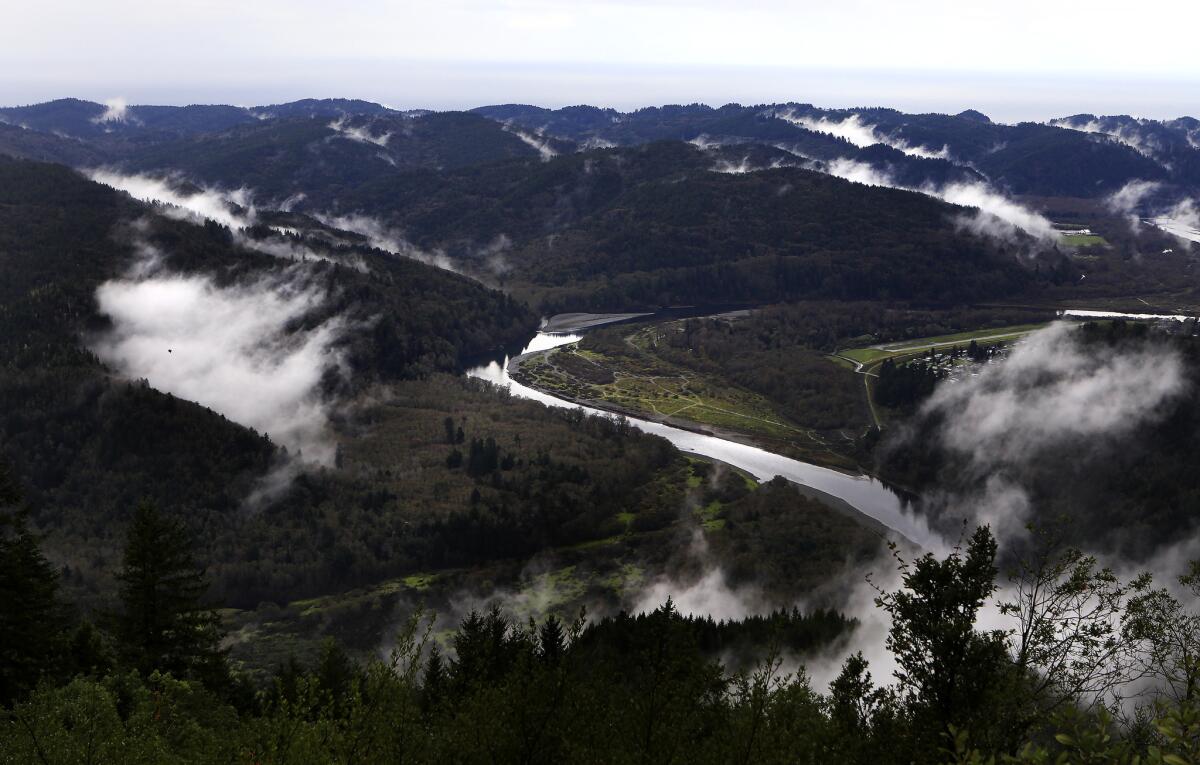Klamath River dams moving toward removal despite congressional barriers

California, Oregon, the U.S. Interior Department and dam owner PacifiCorp are working toward removing four hydroelectric dams on the Klamath River.
- Share via
California, Oregon and the federal government are working on a way around congressional barriers to the removal of hydroelectric dams on the Klamath River.
The states, the U.S. Interior Department and the owner of the dams, PacifiCorp, announced Tuesday that they have agreed in principle to pursue removal through the federal dam relicensing process.
The move comes after a complex deal to decommission four hydroelectric dams and restore portions of the historic salmon river fell apart when Congress failed to act on a crucial piece of the pact by a Dec. 31 deadline.
Republican members of Congress and local elected officials have argued against dismantling private utility facilities that are the source of property taxes and provide electricity to rural customers in Northern California and southern Oregon.
In the original Klamath deal, struck in 2010, PacifiCorp agreed to the dam removal because it would have cost the company an estimated $400 million to meet state water-quality standards and the Federal Energy Regulatory Commission’s relicensing requirements.
Under the tentative new agreement, the parties would amend the dam-removal piece of the 2010 pact so it does not have to go before Congress. But they would retain funding and other provisions that cap PacfiCorp’s costs and call for California to use state bond money to help pay for decommissioning.
“For the first time, we have all the key parties on dam removal … shoulder to shoulder going to FERC to request decommissioning,” said Rep. Jared Huffman (D-San Rafael), whose congressional district includes the lower Klamath.
“I think everybody is motivated to get this done,” Huffman said. “The administration sees this as an important piece of unfinished business.”
The oldest of the dams was built nearly a century ago. The structures block historical salmon spawning grounds on the upper Klamath and also create stagnant pools of water that breed toxin-producing algae.
The agreement in principle sets a target date of Feb. 29 for the parties to sign an amended dam accord. Some provisions have yet to be worked out, including issues of liability should problems arise during decommissioning.
Most dam removal projects go through FERC, PacifiCorp spokesman Bob Gravely said.
“The scale of what we’re talking about in Klamath is big,” Gravely said. “It’s a lot more complicated than most other dam removal projects. So it’s by no means a done deal. But we’re committed to trying to find a way to do it.”
Farm, tribal and environmental interests have feuded over water for decades on the Klamath, which flows from southern Oregon through Northern California to the Pacific Ocean.
Other elements of the original agreements were intended to end many of the fights by spelling out water allocations for irrigators and wildlife refuges and settling water-rights disputes.
The new deal does not address those lingering issues. But in a statement, Interior Secretary Sally Jewell called it “an important initial step as we work toward a comprehensive set of actions to advance the long-term progress and sustainability for tribes, fisheries and water users across the Klamath Basin.”
Twitter: @boxall
ALSO
Several more possible Zika cases in L.A. County
Fire at Roosevelt High School in Boyle Heights investigated as arson
L.A. leaders want someone overseeing oil operations in the city full time
More to Read
Sign up for Essential California
The most important California stories and recommendations in your inbox every morning.
You may occasionally receive promotional content from the Los Angeles Times.











